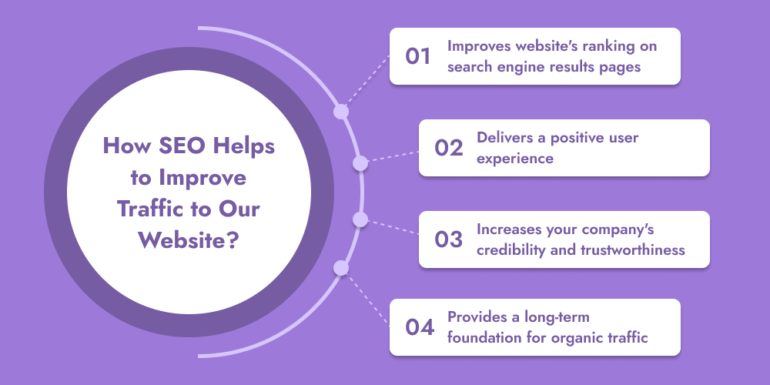Ever wonder how some websites magically appear at the top of your search results? That’s not fairy dust, it’s the magic of search engine optimization. Think of SEO as the culinary art of the digital world. Just as the right ingredients can make a dish stand out, the right SEO techniques can elevate a website’s presence. Want to learn? Let’s dive right in!
Introduction to SEO
Search engine optimization, commonly known as SEO, is the practice of improving a website to improve its visibility on search engines like Google. By employing search engine optimization strategies, businesses can significantly boost organic traffic to their sites, leading to greater visibility and potentially increased sales or conversions.
The Best Strategies to Increase Website Traffic
Here are some of the SEO techniques that will help you boost organic traffic:

1. On-Page SEO Optimization
Ever judged a book by its cover? Well, search engines kinda do that with your website. On-page SEO optimization ensures your website’s “cover” is captivating and involves improving the elements directly on your website. From meta descriptions to alt texts, it’s about making sure everything on your website appeals to both users and search engines.
This includes optimizing title tags, meta descriptions, URLs, and content. These elements tell search engines what your content is about and help rank your website accordingly. Furthermore, ensuring a fast-loading website, integrating internal links, and having an XML sitemap can also influence on-page SEO.
Digi-Tip: Keep title tags within 50-60 characters and meta descriptions within 120-158 characters.
2. Off-Page SEO Strategies
While on-page deals with optimizations on your website, off-page SEO strategies focus on activities outside your site. Use link building for improved traffic which is about getting other reputable websites to link to yours. These backlinks act as votes of confidence in your content. Strategies can range from guest blogging, skyscraper content, or even outreach to sites that might find your content valuable. The idea is to build a website’s authority in its niche, making search engines more likely to rank it highly.
3. Keyword Research for SEO
Keyword research for SEO is the foundation of SEO. It’s all about understanding the phrases and terms your potential customers are using when they search. Tools like Google’s Search Console or SEMrush can help identify high-volume keywords that are relevant to your business. Once identified, these keywords should be naturally integrated into your content.
Digi-Tip: For local businesses, local SEO strategies for website traffic are a game-changer, as they ensure locals find you easily.
4. Content Optimization for Search Engines
Quality content is central to SEO. Content optimization for search engines means producing valuable content tailored to your audience while ensuring it’s easily understood by search engines.
Tips for Effective Content Optimization
- Understand Your Audience: Before you pen a single word, have a clear picture of whom you’re writing for. Tailor your content to their needs, interests, and language.
- Incorporate Relevant Keywords: Once you’ve identified your primary keywords through keyword research, incorporate them naturally into your content. Avoid keyword stuffing, as this can be detrimental.
- Use Headings and Subheadings: Proper formatting makes your content more readable. Use H1, H2, and H3 tags to structure your content and incorporate your keywords where they fit naturally.
- Optimize Images: Visuals break up text and make your content more engaging. Ensure that images are optimized for size and load quickly. Also, use descriptive alt text for each image, which helps search engines understand the content of the image.
- Maintain Readability: While it’s essential to use keywords, ensure your content remains readable. Use short sentences, bullet points, and plenty of white space.
- Regularly Update Content: Search engines favour fresh and updated content. Regularly review and update your articles or blogs to keep them current and relevant.
- Optimize Meta Descriptions: Though meta descriptions don’t directly impact search rankings, a compelling description can increase click-through rates from the search engine results page.
- Ensure Mobile-Friendly Content: With an increasing number of users accessing content via mobile devices, ensure your content is responsive and appears well on mobile screens.
Digi-Tip: Include internal links to other relevant content on your website. This not only helps in guiding the reader to more of your content but also boosts your SEO.
5. Voice Search and SEO
With the rise of digital assistants like Siri and Alexa, optimizing for voice search has become crucial. Voice search and SEO involve understanding and optimizing for the more conversational and natural queries users make when speaking rather than typing.
How can businesses effectively optimize their websites for voice search? Voice search is like the new kid on the SEO block, and it’s rapidly gaining popularity. Here’s how businesses can adapt:
- Conversational Keywords: People speak differently than they type. Use natural-sounding phrases in your content.
- Featured Snippets: Aim for these since voice assistants often read out the featured snippet in search results.
- Local SEO: Many voice searches are local. Ensure your business has a Google My Business listing and is optimized for “near me” searches.
- Website Speed: Voice search users want quick answers. A faster-loading site is more likely to be chosen by voice assistants.
Adapting to voice search can place your business at the forefront of this growing trend.
6. E-commerce SEO Techniques
If you run an online store, E-commerce SEO Techniques can make the difference between someone finding your products or your competitors. This involves optimizing product descriptions, improving site structure, and ensuring a seamless user experience to reduce cart abandonment rates.
7. Mobile SEO and Its Impact
How does mobile SEO impact organic website traffic? Ever tried to read a newspaper through a keyhole? That’s how users feel when a website isn’t mobile-optimized. With a majority of searches conducted on mobile devices, mobile SEO ensures websites are responsive and load quickly on these devices. A mobile-friendly site retains users, leading to a reduced bounce rate and higher organic rankings.
How SEO Helps to Improve Traffic to Our Website?

When implemented effectively, SEO ensures a website is easily accessible, comprehensible, and attractive to search engines. Here’s how it works:
- Visibility and Rankings: By optimizing elements like keywords, meta descriptions, and backlinks, SEO improves a website’s ranking on search engine results pages. The higher you rank, the more visible you are to potential visitors.
- User Experience: SEO isn’t just about pleasing search engines. It’s also about delivering a seamless and positive user experience. Websites that are easy to navigate, read, and browse are more likely to retain users, leading to increased engagement and traffic.
- Credibility and Trust: Websites that appear on the first page of search engine results are often viewed as more credible and authoritative. By achieving these top spots, users are more likely to trust and visit your website.
- Long-Term Strategy: While SEO doesn’t deliver overnight success, it provides a long-term foundation for sustained organic traffic, making it a consistent source of visitors.
The Current Trends in SEO for Improving Organic Traffic
Staying updated is key. Currently the SEO trends are:
- User Experience (UX) and Core Web Vitals: Google has been emphasizing the importance of user experience. Metrics like loading performance, interactivity, and visual stability play a crucial role.
- Long-form Content: Comprehensive and long-form content tends to rank better as it provides in-depth information, keeping readers engaged.
- Artificial Intelligence (AI): AI, especially Google’s BERT algorithm, is becoming a significant factor in understanding user searches and delivering accurate results.
Know about SEO trends and updates, and you’ll be on your way to improving organic traffic.
SEO Tools and Resources for Measuring SEO Success
Want to know how your SEO efforts are paying off? Here are some essential tools:
- Google Analytics: To analyze website traffic, user behavior, and conversions.
- Google Search Console: For insights into your site’s organic search performance, including clicks, impressions, and site errors.
- SEMrush, Moz Pro, or Ahrefs: To analyze backlinks, track keyword rankings, and study competitors.
Remember, it’s not just about gathering data, but also interpreting it to make informed decisions.
Summary of How to do SEO for Organic Traffic
The summary of steps for boosting organic traffic are the following:
- Understand Audience: Know their needs and tailor content accordingly.
- Keyword Research: Use tools like SEMrush or Ahrefs to identify relevant, high-volume keywords.
- On-Page SEO: Optimize title tags, meta descriptions, URL structures, content, and use internal links.
- Website Speed: Ensure a fast site using tools like PageSpeed Insights.
- Security: Use HTTPS for a secure browsing experience.
- Mobile-First: Ensure your site is responsive for mobile users.
- Quality Backlinks: Obtain links from authoritative websites in your niche.
- Local SEO: If relevant, optimize for local searches and create a Google My Business listing.
- Update Content: Keep content fresh and up-to-date.
- Track Performance: Use analytics tools to measure and refine your strategy.
As the digital landscape evolves, the importance of optimizing your website for search engines remains constant. With the right strategies and a commitment to continuous learning, you can effectively increase your website’s visibility and organic traffic.




